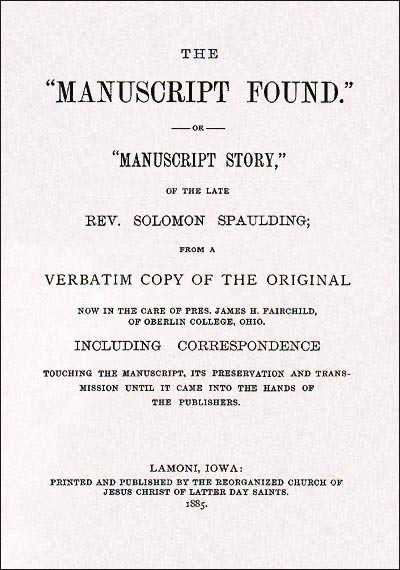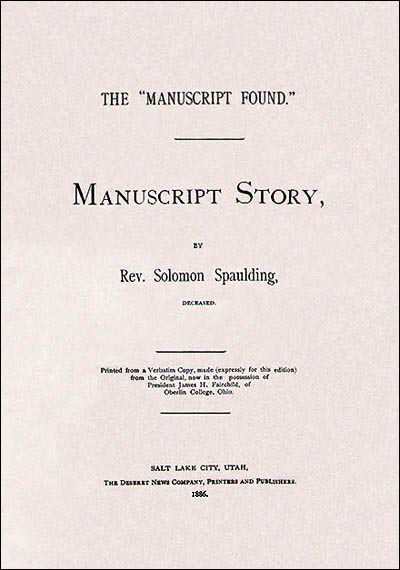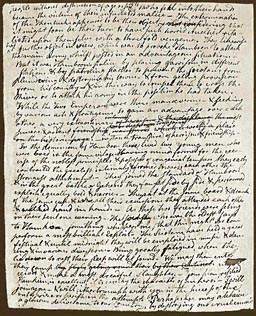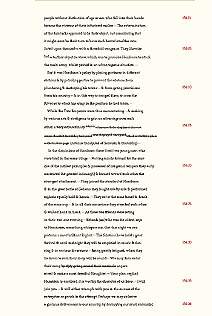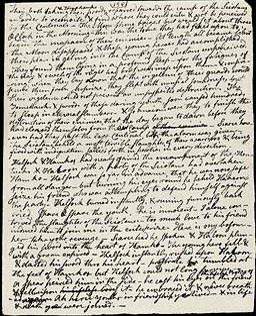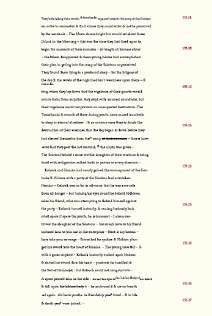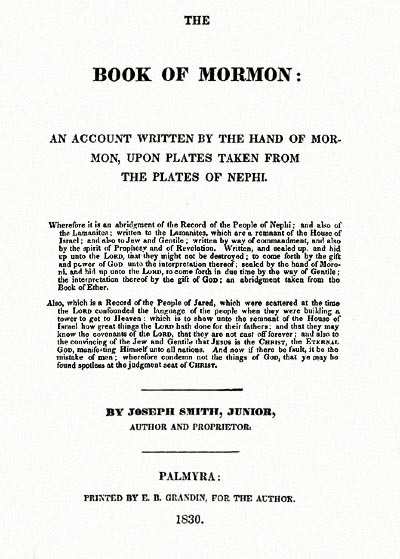
- Dale R. Broadhurst's SPALDING RESEARCH PROJECT -
|
The Dale R. Broadhurst "Spalding Papers" |

|
Paper #01: A Proposal For a Comparative Study...
|
For a Comparative Study of the Textual Affinities in the Solomon Spaulding Manuscript and The Book of Mormon submitted to: Dr. Jeffery Holland Commissioner of the LDS Church Educational System on: August 13, 1979 |
|
For a Comparative Study of the Textual Affinities in the Solomon Spaulding Manuscript and The Book of Mormon Contents I. A DESCRIPTION OF THE PROPOSED RESEARCH |
Note 2.: Pages 14-16 not transcribed.
|
||||||||
|
The Oberlin Spaulding Manuscript Pages 154-155 Notes MS page 154: The name Hamko is Spaulding's revision of the name Hamkien. In line 28 Hamko is written over Hamkien. In line 35 Spaulding did not correct the original name, probably by oversight. This letter fact is important, for it may indicate that Spaulding had not carefully re-read this manuscript in order to make revisions of the type which would have had to be made before a printer could have set the text for publication. MS page 155: The name Haloon shows signs of having been changed from Haboon[/Hakoon]. The word again on line 36 was written over some other indecipherable word. The changing of you to ye appears to be a rather unusual case of re-thinking on Spaulding's part. What his reasoning was in making such a change is now difficult to determine, but he may have been having thoughts of staying closer to the archaic forms similar to those [found] in the "King James" English of earlier times. |
|
The Oberlin Spaulding Manuscript CONCORDANCE Extract for MS pages 154 and 155 Note 4.: I typed up the original concordance extract for pages 154 and 155 in August of 1979, prior to my personal inspection of the Solomon Spalding holograph on file in the Oberlin College Archives. Since that time I have prepared a more extensive and reliable computerized concordance for the Spalding MS. As this more recent work was speedily carried out with the help of a computer database management program, spreadsheet processing, spell-check functions, etc., the results obtained were far less problematic than the outcome of my prior hand-work (as outlined on page 30 of this Proposal). The new concordance is an unpublished, computer word-processor format document, the contents of which cover the entire 171 pages of text found in the Oberlin holograph. At some future date I will re-compile this digital concordance as an html resource, utilizing the resources of William A. Williams' on-line concordance program and the accompanying Spalding e-text available at HTTP://WWW.concordance.COM/mormon.htm. In re-formatting pages 31-51 of my "Book of Mormon Research Grant Proposal" as a web-document I have revised the concordance extract in some places to match the contents of my more recently compiled word-processor text. Because of this re-formatting and revision of the presented data, the results offered here differ slightly from those in the 1979 original for pages 31-51. Dale R. Broadhurst November, 1998 EXPLANATION So far as I know this is the first attempt ever made to prepare a concordance of the text from the Spalding MS. Were it not for the fact that the work has a been a subject of great controversy for so many years, I seriously doubt that such an effort could have ever been thought to be a worthwhile use of [anyone's] time. Only MS pages 154 and 155 were used in this effort, since it was conceived as a tool for working within the narrow limits of the model study of those two pages. Such a task is not quickly done, even when so limited. Each word occurring in the previously prepared transcript was listed along with the surrounding words of the contextual setting an in turn, that list was physically cut up and pasted back together in alphabetic order. The use of such crude methods lengthened the task to a period of several days of continual work. It is therefore highly suggested that any future extension of this labor be carried out through the use of modern, automatic data processing equipment. The following words [did] not appear in the [original 1979] list due to their ubiquity and numerous instance of occurrence. They are given here to complete the listing for quantitative [analysis] purposes.*
* Some word counts and spellings may differ slightly from those stated in 1979 original document, due to my use of the 1980 revised text in the concordance tables. For the revised transcripts please see MS page 154 and MS page 155. - A -
|
|
The [Oberlin] Solomon Spaulding Manuscript [TEXTUAL AFFINITIES] Extract from "A Preliminary List of Textual Affinities Between the Spaulding MS and the Book of Mormon" Note 6: Prior to the August 1979 completion of my "A Proposal For a Comparative Study of Textual Affinities in the Solomon Spaulding Manuscript and the Book of Mormon," I had already prepared its precursor in the form an unpublished research paper submitted to the RLDS Historian's Office in April of 1979. This earlier, much more primitive document was entitled, "A List of Textual Affinities Between the Book of Mormon and 'Manuscript Story.'" As this very preliminary tabulation was in many respects an unfinished document, I sent a re-written compilation of more or less the same material to the RLDS Historian's Office in June of 1979. This second effort was entitled, "A Preliminary List of Textual Affinities Between the Spaulding Manuscript and the Book of Mormon." In June of 1979 I prepared "A Preliminary List of Textual Affinities Between the Spaulding Manuscript and the Book of Mormon" for certain officials in the RLDS Church. At that time I did not have access to a full set of good photocopies of the Spaulding manuscript, so I made use of the 1885 RLDS published transcript of the text. I feel that this list brings to light a great number of affinities in the two texts, many of which really require further investigation [in order for us] to determine their exact relationship one [to] another. In the previous Appendix [pp. 29-68] some examples of textual parallels taken from a very limited portion of Spaulding's work were examined. The extract given here further indicates that those parallels found on MS pages 154 and 155 are not unique, but rather only a small part of a very lengthy list of such occurrences in the two texts. In the following listing only the Spaulding word groupings are given: no Book of Mormon cross-referencing has yet been prepared from my original notes on the subject. The examples given are either identical or near identical [word group] occurrences from both texts and are of the "highly unexpected" variety. The page numbers accompanying the quotes are from the 1885 RLDS edition of Spaulding's romance. In a couple of instances the text used is the 1886 LDS edition's, however. In most cases the word groups can be found just as listed in both works, but in a few instances two passages from the Book of Mormon are required to match the quote in its totality. Also, in a few cases the passages in the Book of Mormon which are in parallel with those of the list are not exact word-for-word copies of the Spaulding phraseology, but are rather close approximations.
page 11: near the... bank of the... river
numbers of those people who
with the assistance of a lever
page 12: the box was taken and
I found that it contained
in the arts of war
page 15: spread... over the face of the
page 28: maintain our... religion
page 30: to the land of our nativity
a narrow strip of
along the banks of this river
page 31: lest we should fall into the hands of
page 36: had a plenty of provisions at all seasons
page 42: he put forth his hand and
page 63: be for the benefit of the
ordained hugh priest
page 64: his... son whose name was
to ordain... their high priest
page 65: bade... adieu
page 73: their villages and cities were
page 74: timber on top of
and likewise... storehouse... the reception of
to defend themselves against
page 75: for the space of... years
page 76: the eldest daughter of
page 77: the darkness of night
page 94: when... had received this letter he
page 96: the calamities of
page 97: blood and carnage
page 98: cast up his eyes toward heaven
hear a thundering voice... from the
page 101: the great founder of
page 103: in the cause of their country and their God
at the head of a great multitude
page 110: to make... preparations for war
page 112: spreading carnage
the field of battle
page 114: be stained with the blood of
page 116: determined to conquer or die
the blood of brothers (brethren?)
page 118: the greatest slaughter
was covered with the bodies
page 121: an immense slaughter
was only the beginning of the war
page 125: them... in a profound sleep
page 126: had taught them to use stratagem
page 127: the narrow passage which led to the
page 130: beheld army marching towards them
page 132: blood and carnage
page 133: fled to the army of
page 135: placed himself at the head of
broke down the door
page 136: listen to the cries of
surrounded by the walls of
page 137: band of murderers
page 138: the... was covered with the dead
page 140: pursued them with his
returned in great haste
great was the joy of the
had fallen by the sword
page 141: he marched with the remainder
Book of Mormon. Any one of these parallels, taken by itself, appears to be of little consequence; but the larger patterns [formed] by these textual affinities are truly worthy of study. |
|
TEXTUAL COMPARISONS BIBLIOGRAPHY Note 7.: The Textual Comparisons Bibliography which follows was reproduced with essentially the same content in my 1980 revision of this Proposal into my "Spaulding Research Project Working Paper No. 1." The only substantial difference between this Proposal appendix and this same section in the 1980 Working Paper was the addition to the latter of a note which followed the information in item number 07. In this e-text I have reformatted that note as "item 07b." within the main body of the bibliography. To distinguish this addition from the rest of the bibliographic material I have reproduced it in red type. Ever since the 1834 appearance of Eber D. Howe's Mormonism Unvailed writers have tried to make comparisons of the writings of Solomon Spaulding with the Book of Mormon. Howe, who had the [Oberlin] Spaulding Manuscript in his possession, did not make a close study of it, but instead presented a series of statements by various people who equated portions of the Book of Mormon with another manuscript of Spaulding's which was probably titled "Manuscript Found." Until after 1884 that same approach was used by the anti-Mormon writers, until the number of statements gathered reached a very high number. Some writers compiled rather detailed lists based upon the conflicting evidence given in all of these statements, but [lists of] supposed affinities were of little value without the proof of the actual manuscript. When the [Oberlin] Spaulding manuscript came to light in 1884 the emphasis of the pro-Spaulding [theory] writers shifted to examinations of the long lost work now published and available to all. Actually, such comparisons had already been written, being based upon a summary of the work given in Howe's 1834 book. However, that summary was so short as to be of little value to those who sought to link the Nephite record to Spaulding's fiction. Initial examinations of the manuscript added little information. Rice and Fairchild dismissed it as not related to the Book of Mormon and most people interested in the matter accepted their opinions. But within a few years after the find some investigators began to notice numerous similarities between the MS and the Book of Mormon. I will give a brief bibliography of some of the more useful lists compiled to date below. This list is based upon a less than exhaustive review of the literature and is not presented as complete. Additions will be gratefully received by this writer. 01. Howe, Eber D. Mormonism Unvailed, Painesville, Ohio 1834. Howe relates the finding (by D. P. Hurlbut) of the Solomon Spaulding MS and gives a brief synopsis of the story, which, according to the residents of Conneaut, Ohio, "bears no resemblance to the 'Manuscript Found.'" Howe's summary served as the only concrete example of the writings of Spaulding until the MS find in 1884 in Hawaii. As such, it was the basis for some of the early comparisons of thematic elements. 02. Haven, John "A Cunning Device Detected," Times and Seasons vol. I no. 3 (January 1840) p. 47. (reprinted from the Quincy Whig. This report of an interview with Spaulding's widow touches upon the area of similarities between his writings and the Book of Mormon. It is difficult to be certain that the widow is referring to the same manuscript which was found in Hawaii. Her statement that in the two texts "some few of the names are alike" may refer to the similarity of such MS names as [Jesus] and Labanco to Book of Mormon names like [Jesus] and Laban. 03. Winchester, Benjamin The Origin of the Spaulding Story, Philadelphia 1840, p. 20. Winchester quotes from Howe on the nature of the manuscript and concludes: "Now any one who has read the Book of Mormon, knows that the contents are altogether dissimilar from this description." In this statement Winchester sets the pattern for almost all future LDS comment on the two works; most later writings are only restatements of this thought by the early Mormon author. 04. Patterson, Robert "Solomon Spaulding and the Book of Mormon" in History of Washington County, Pennsylvania (Boyd Crumrine, editor) Philadelphia, 1882, pp. 425ff. Patterson, though representing an anti-Mormon viewpoint, still remains the earliest writer who attempted to fathom the Book of Mormon origins. While other non-Mormons used the Spaulding theory as a weapon against the [restoration] movement, Patterson appears to have tried very hard to understand and state what he felt to be the truth of the matter. Some of his insights are still worth reading today -- especially his comparison of the Howe summary with the story of the Book of Ether in the Book of Mormon. 05. Reynolds, George "Internal Evidences of the Book of Mormon" in The Juvenile Instructor Vol. XVII (1882) pp. 235-238, 262-263. This is the first real attempt from the Mormon viewpoint to compare the reported textual elements of the "Manuscript Found" with the Book of Mormon. This theme is expanded in his The Myth of Manuscript Found which was published the next year as the 11th book in the LDS "Faith Promoting Series." Unfortunately the speculation concerning the contents of the "Manuscript Found" has remained only speculation. Unless that particular manuscript ever comes to light, speculation such as [that] presented by Reynolds is of very little practical use. 06. Kelley, Ed. L. & Braden, Clark Public Discussion of the Issues Between the R.L.D.S. and the Church of Christ (Disciples), St. Louis, 1884. This transcript of a debate held in Kirtland contains a wealth of information on the Spaulding theory from both pro and anti viewpoints. The entire discussion of Proposition #1 is an excellent review of the theory as it stood just before the Hawaii MS find. See especially Braden's 6th Speech and Kelley's 9th Speech for comparisons of the reported "Manuscript Found" with the Book of Mormon. Braden appears to have viewed the [Oberlin] Solomon Spaulding manuscript as a sort of rough draft of the "Manuscript Found," so his remarks apply to both stories at some points in his discussion 07a. Fairchild, James H. Manuscript of Solomon Spaulding and the Book of Mormon (a paper read before the Northern Ohio and Western Reserve Historical Society, March 23, 1866 and published in Tract no. 77, Western Reserve Historical Society, Cleveland, Ohio.) In the first real comparison of the [Oberlin] Spaulding manuscript with the Book of Mormon, Fairchild finds little in common between the two. Though personally involved, Fairchild does not appear to have had an adequate background in the Book of Mormon. Thus, just because he was a man of advanced education and helped in the bringing forth of the lost manuscript he is often credited as having given the definitive statement on the non-relationship of the two works. His remarks are quoted in most major Mormon works on the subject, perhaps without [any understanding] of [just] how limited his knowledge of the Book of Mormonreally was. 07b. Whitsitt, William H. "Mormonism" in S. M. Jackson's Concise Dictionary of Religious Knowledge, 1891 (A summary of "Sidney Rigdon, the Real Founder of Mormonism") Although Dr. Whitsitt wrote extensively on the origin of the Book of Mormon and had a copy of the MS found in Hawaii in his possession, he had very little to say about how little or how much the texts of those two works resembled each other. This writer had nearly completed his massive Sidney Rigdon biography when the Spalding story discovered in Honolulu was announced to the world. The few thematic parallels noted by Whitsitt are his attempt to provide documentation for the idea that the Book of Mormon story line was developed from a Spaulding authored Book of Ether. Whitsitt felt he could detect a pattern of literary evolution extending from the Oberlin manuscript's story, through the Jaredite account, and on into the Lehite records. Without having the Oberlin document in hand during most of his investigations, however, Whitsitt did not wite a detailed explanation of his idea. 08. Whitney, Orson History of Utah, Salt Lake City, 1892-1904. In the third chapter of the first volume of this work Whitney gives a good review of the Spaulding issue. On page 50 he appears to admit a "few" similarities between the [Oberlin] MS and the Book of Mormon, but he does not support any connection between the two works. He does give some interesting side-by-side comparisons of the two texts. 09. Smith, Joseph F. "The Manuscript Found" in Improvement Era Vol. 3 no. 4 (February, 1900) In the first installment in a three issue article article on the Spaulding theory, LDS President Joseph F. Smith quotes L.L. Rice, saying that the only resemblance between the MS and the Book of Mormon is that they both "give an account of American Indians." 10. Schroeder, Theodore A. The Origin of the Book of Mormon Reexamined . . . Salt Lake City, 1901.) Schroeder was the first anti-Mormon to revive the Spaulding theory after the Hawaii find. He appears to have looked at the [Oberlin] MS as a rough draft for the reported "Manuscript Found." On page 4 he makes a remark of how the story resembles that of the Book of Mormon. Such unsupported statements are as vague as Mormon claims that there are no similarities in the two works. However, Schroeder had a considerable effect on later writers and opened up the idea that the [Oberlin] Solomon Spaulding MS might indeed have some connection with the record of the Nephites. 11. Evans, John H. One Hundred Years of Mormonism, Salt Lake City, 1905. Evans gives considerable space to a discussion of the Spaulding theory in this well accepted older history. It [marks] a turning point in the Mormon view on the subject, in that he says: "there are some general resemblances between this work and the Book of Mormon, both in content and in external details . . ." Evans seems to have noticed both the textual similarities of the two works and the parallels in Joseph Smith's history of the coming forth of the Book of Mormon and Spaulding's account of the bringing forth of his "Roman record." This point is quite important, for the double parallel was not acknowledged by Mormon writers until Evans announced it. 12. Meyer, Eduard The Origin and History of the Mormons, Halle, Germany 1912. (available in a 1961 English translation by Rahde and Seaich, Salt Lake City, 1961). This European writer listed four parallels between the two works (see p. 26 of the English translation) but all are superficial in and of themselves and two are exaggerations of the actual case. Thus. while Meyer was one of the first to list actual parallels, his work is of limited usefulness. 13. Roberts, Brigham H. New Witnesses for God, Vol. II The Book of Mormon Salt Lake City, 1909. Roberts makes a statement on page 385 of this work which is worthy of quotation here: Composition in writers becomes individualized as distinctly as the looks, or appearance, or character, of separate individuals; and they can no more write in several styles than individuals can impersonate different characters . . . underneath these impersonations is to be seen the real individual; and so with authors. As we have in this (the Spaulding Manuscript) enough of Mr. Spaulding's style to determine its nature; if this manuscript of his was used either as the foundation or the complete work of the Book of Mormon, we should be able to detect Spauldingisms in it; identity of style would be apparent; but these things are entirely absent from every page of the Book of Mormon. Although I do not agree with Roberts' conclusion that there are no Spauldingisms on the Book of Mormon, I feel that he has a good point stated in the rest of his discussion. Though Roberts was a staunch defender of the Book of Mormon on this issue, he did note parallelism in Joseph Smith's History and the Spaulding Manuscript (see 14. below). 14. Roberts, Brigham H. "Manuscript of Parallels" (unpublished manuscript with no date, copy in the RLDS Library and Archives). This remarkable work is a comparison of the Book of Mormon with Ethan Smith's View of the Hebrews. On page 2 of the parallels listing Roberts makes another statement worth quoting: Has your attention ever been called to at least one striking passage in the Solomon Spaulding Book as published by our Church, which suggests something of a parallel to the description given above of this stone box as found by our prophet? It is given by Spaulding in connection with his finding the manuscript of his book . . .This quote was discussed by RLDS writer Charles A. Davies in "'View of the Hebrews' and the Book of Mormon" in The Saints' Herald Vol. 109 no. 15 (Aug. 1, 1962) pp. 537ff. Davis thought that this one parallel seen by Roberts was "the only similarity between the Book of Mormon and the Spaulding romance." As this unpublished manuscript was written late in Roberts' career, I cannot help but think that he may have had some second thoughts on the possible link of Spaulding to Mormonism, at least in regard to the Joseph Smith account of the coming forth of the Book of Mormon. [I cannot help but] wonder if Roberts may have not left behind other unpublished works investigating a possibility such as this. 15. Shook, Charles A. The True Origin of The Book of Mormon, Cincinnati 1914. Heavily influenced by Schroeder in his thought on the [Spaulding] theory, Shook was an RLDS author who left the Church and wrote a number of works including this well thought-out volume. Shook was [one of] the first writers who actually sat down and compiled a list of thematic parallels between the Book of Mormon and the Spaulding story. Pages 155 to 165 contain this listing and is "must" reading for anyone investigating the Spaulding theory. Shook's list includes a number of misstatements and a mixing of the Nephite record material and the Joseph Smith History in making a comparison to Spaulding's work. Even so, it was [one of] the first such listings and [it] contains a good core of parallels often quoted by later writers. 16. Homans, J. E. (pseudonym: Robert C. Webb) The Real Mormonism NYC, 1916. On pages 423-426 Homans compares the [Oberlin] Solomon Spaulding MS to the Book of Mormon. Like many anti-theory writers, Homans avoids mentioning the parallels in the texts. 17. Arbaugh, George B. Revelation in Mormonism Chicago, 1932. Arbaugh appears to have drawn upon Shook for his short listing of parallels appearing on pp. 16-18 of this book. Arbaugh does add a few examples to Shook's list and it is worthwhile to read his discussion of the subject. 18. Bown, M.D. "One Hundred Similarities Between The Book of Mormon and the Spaulding Manuscript," unpublished manuscript in the Special Collections of the Harold B. Lee Library at Brigham Young University. (1937?)Though little quoted by recent writers, Bown's lengthy listing of textual parallels is a remarkable work of scholarship on the subject. It appears that this was a paper written for some class at BYU in the mid-thirties. Brother Bown's insight into the material he covers is excellent and his list would be required reading by anyone weighing the evidence of the pro and con sides in the Spaulding issue. A less significant work is A. Dean Wengreen's "An Analysis of 'One Hundred Similarities Between The Book of Mormon and The Spaulding Manuscript" (unpublished manuscript at BYU, copy in the LDS Church Library). Wengreen points out a few minor errors in Bown's thought but resorts to avoiding the issues raised in that author's work by [voicing] his own testimony that the Book of Mormon has no elements of human origin. 19. Bales, James D. "The Book of Mormon and Spaulding Manuscripts" in The Christian Soldier Vol. IV no. 9 (August 14, 1942) p. 5. This list of 49 thematic parallels is not so detailed or well thought out as the Bown work and does not appear to rely upon that earlier paper at all. Nevertheless, both authors cover many of the same points. The Bales listing was expanded to 75 "points of similarity" in his 1958 The Book of Mormon? (Rosemead, California). Though in some areas Bales' work adds to Bown's listing, it is not so strong a list. For comments on the Bales effort see Hugh Nibley's "The Comparative Method" in Improvement Era Vol. 62, no. 10 (October 1959) pp. 741, 759. 20. Hill, Marvin S. "The Role of Christian Primitivism . . ." (unpublished Ph.D. dissertation, University of Chicago, 1968). Beginning on page 95 of this work Hill makes a brief mention of some "superficial similarities" in the MS and the Book of Mormon. Unfortunately he seems to have been unaware of the listings under "Spaulding" in the card Catalogs of the [LDS] Church and BYU collections, for he nowhere mentions the works I have listed under items 18. and 19. [above] which are available to any researcher looking into the subject. Hill's otherwise fine discussion of the subject is marred by this major oversight on his part of important source material which he might easily have drawn upon for a more complete review of the issue. 21. Davis, Howard A. (with D.R. Scales & W.L. Cowdrey) Who Really Wrote the Book of Mormon> Santa Ana, Calif. 1977 On pages 247-253 these authors discuss parallels between the Spaulding MS and the Book of Mormon and promise further such examples in a "forthcoming book." These authors also appear to be unaware of previous work done on the subject. Their list is weak and short and does little to support their [stated] point of view. 22. Bush, Lester E. "The Spalding Theory Then and Now" in Dialogue Vol. X no. 4 (Autumn 1977) pp. 40ff. Of all the Mormon writings on the subject, Lester Bush;s article is the most detailed, open, and [seemingly] honest effort I have yet come across. While he tends to support the anti-Spaulding [theory] view, he makes such statements as: ". . . there are unmistakable parallels in Spalding's introduction and Joseph Smith's early experiences." (p. 42). On page 56 Bush carefully selects a few parallels between the Book of Mormon and the Spaulding MS and discusses them in a footnote. One gets the feeling that Bush is walking a tightrope: admitting a few parallels but not really confronting the Bown and Bales lists and giving any real explanation [for] these numerous thematic elements which do occur in both the Spaulding manuscript and the Book of Mormon. 23. Broadhurst, Dale R. "A Preliminary List of Textual Affinities Between the Spaulding Manuscript and The Book of Mormon" (unpublished 50 page report on thematic and vocabulary affinities) June 1979. Though there have been a number of lists dealing with the structural or thematic elements which are similar in the two texts, this was the first listing of identical and near identical phraseology in the MS and the Book of Mormon. Also contained in the paper are some thematic similarities not noticed by previous writers. This preliminary report was not intended for publication and falls far short of even beginning to list the hundreds of [instances] of identical phraseology [in these two works.] 24. Broadhurst, Dale R. "The Coming Forth of the Book of Mormon in Relation to Solomon Spaulding's Manuscript Story" (unpublished research paper, August, 1979). Previous listings and discussions of parallels usually ignored the fact that there are two different Mormon writings which have very high instances of "Spauldingisms" in their texts. The better known example is the Book of Mormon but Joseph Smith's "History" as published in the Times and Seasons can be considered just as good of an example in the account of the coming forth of the Book of Mormon. Evans, Roberts and Bush all noticed these strange similarities and commented on them. What is quite remarkable is that Smith was no doubt aware of the Howe and Hurlbut charges and should have been particularly careful to refrain from mixing any "fiction" into his account of finding the plates for the Nephite record. Even so, the account has a distinct "Spauldingish" ring to it, both in structure and in phraseology. The Smith account and the Spaulding account are so close to each other that they read like products of the same pen. This paper examines the two accounts in detail, noting identical word groups and identical structure in a number of places [in the texts.] No doubt there are other [works] I have missed in the preparation of this bibliography. In at least one instance I have come across letters which contain [comparison] listings and there is a possibility of finding similar material in old journals or unpublished manuscripts. It has been pointed more than once that lists of textual similarities do not prove any connection between two literary works. Identical vocabulary and identical structure do not prove connections either. Even if it could be shown that Spaulding wrote a work almost identical to the Book of Mormon [that by itself] would not be necessary and sufficient proof that Smith copied from him. If such an example were to be had, I am almost certain that it would be explained away as Spaulding's somehow "tapping into" the truth of the Nephites. Lists prove nothing but [their compilation does help] lay the groundwork for further investigation. The lists show that there are unusual similarities in the two works. The day is fast approaching when someone will have to look beyond the textual aspect and start looking for "hard evidence" of a link between Spaulding and the writings of the early restoration. It is just possible that something of that nature might surface with proper research and we should be ready for such a development if it comes. |
back to top of page
Broadhurst Papers: <-> 02 03 04 08 09 10 11 12 13 14 15 16
Return to: Spalding Studies Research | SRP Section | DRB Papers Index | "Home"
Special Collections | Bookshelf | Mormon Classics | Newspapers | History Vault
Last Revised: Oct. 16, 2005
